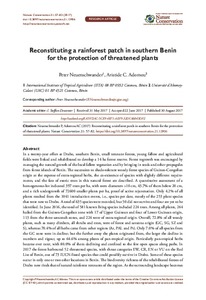| dc.description.abstract | In a twenty-year effort at Drabo, southern Benin, small remnant forests, young fallow and agricultural fields were linked and rehabilitated to develop a 14 ha forest reserve. Forest regrowth was encouraged by managing the natural growth of the local fallow vegetation and by bringing in seeds and other propagules from forest islands of Benin. The succession to shade-tolerant woody forest species of Guineo-Congolian origin at the expense of extra-regional herbs, the co-existence of species with slightly different requirements, and the fate of exotic trees in this natural forest are described. A quantitative assessment of a homogeneous lot indicated 397 trees per ha, with stem diameters >10 cm, 43.7% of them below 20 cm, and a rich undergrowth of 72600 smaller plants per ha, proof of active rejuvenation. Only 4.2% of all plants resulted from the 1041 introduction events, i.e., species per date, mostly of the 253 plant species that were new to Drabo. A total of 635 species were recorded, but 50 did not survive and four are yet to be identified. In June 2016, the total of 581 known living species included 224 trees. Among all plants, 244 hailed from the Guineo-Congolian zone with 17 of Upper Guinean and four of Lower Guinean origin, 113 from the three savannah zones, and 224 were of extra-regional origin. Overall, 72.8% of all woody plants, such as many climbers, all shrubs and trees, were of forest and savanna origin (GC, SG, SZ and S), whereas 70.4% of all herbs came from other regions (At, PAL and Pt). Only 7.0% of all species from the GC zone were in decline; but the further away the plants originated from, the larger the decline in numbers and vigour, up to 64.6% among plants of pan-tropical origin. Particularly pan-tropical herbs became ever rarer, with 80.0% of them declining and confined to the few open spaces along paths. In 2017 the forest harboured 52 threatened species, with threat categories EW, CR, EN or VU on the Red List of Benin, out of 73 IUCN-listed species that could possibly survive in Drabo. Some of these species occur in only one or two other locations in Benin. The biodiversity richness of the rehabilitated forests of Drabo now rivals that of natural rainforest remnants of the region. As the surrounding landscape becomes ever more impoverished because of the high human population and its ever increasing impact, the maintenance of such managed islands of biodiversity is critical. By establishing rare local species from other locations we can compensate for direct human destruction and long-term stochastic loss of species in this highly fragmented landscape where natural seed dispersal is difficult. |

